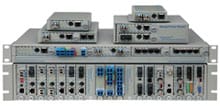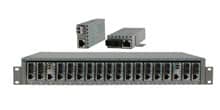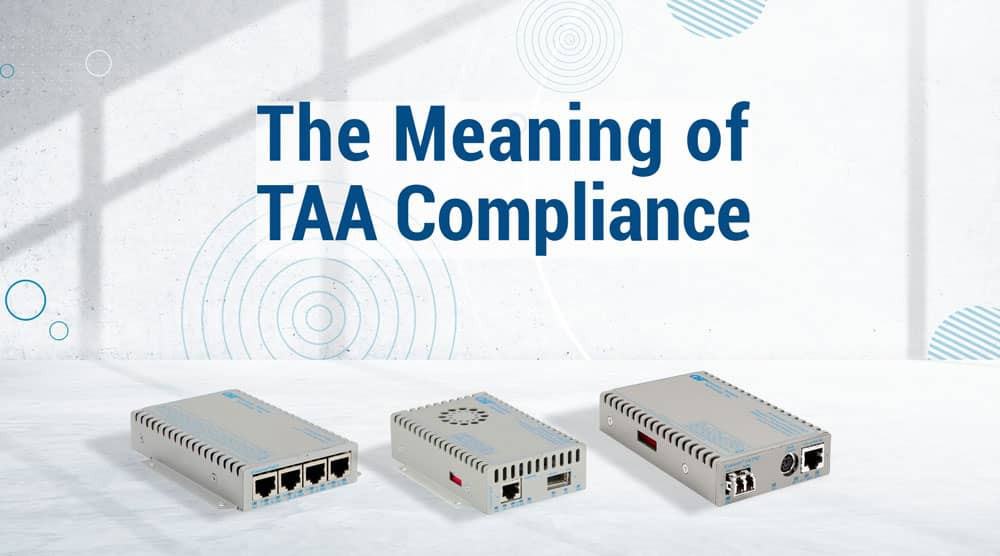- Products
- PoE Media Converters and Switches
- Ethernet & PoE Switches Product Selector
- Multi-Gigabit Ethernet and PoE Switches
- PoE PSE Commercial Switches
- PoE PSE Industrial Fiber Switches
- PoE Industrial Copper Extenders
- PoE Powered Media Converters
- PoE PSE Media Converters
- PoE Extenders & Injectors Product Selector
- Pluggable Transceivers Product Selector
- Product Lines

- iConverter Managed Multi-service Platform
- Copper to Fiber Media Converters
- Ethernet Media Converters
- 10 Gigabit Copper-to-Fiber
- 10/100/1000 Copper to 10 Gigabit Fiber
- 10/100/1000 Copper-to-Fiber with Integrated Management
- 10/100/1000 Industrial Copper-to-Fiber with Integrated Management
- 10/100/1000 Copper-to-Fiber with VLAN
- 10/100/1000 Dual Media Converter with VLAN
- Gigabit Copper-to-Fiber
- 10/100 Copper-to-Fiber with Integrated Management
- 10/100 Industrial Copper-to-Fiber with Integrated Management
- 10/100 Copper-to-Fiber with VLAN
- 10/100 Copper-to-Fiber
- Fast Ethernet Copper-to-Fiber
- Fast Ethernet Redundant Links
- 10Mbps Copper-to-Fiber
- 10Mbps Copper to Coax
- TDM Media Converters
- Serial Media Converters
- Ethernet Media Converters
- Fiber to Fiber Media Converters
- 10 Gigabit Fiber-to-Fiber Converter and Transponder
- 10 Gigabit Industrial Converter and Transponder
- SFP-to-SFP Fiber Converter and Transponder
- SFP-to-SFP Industrial Fiber Converter and Transponder
- Gigabit Fiber to-Fiber with 3 Rs
- 100/1000 Fiber-to-Fiber with 3 Rs
- Gigabit Fiber-to-Fiber
- Fast Ethernet Fiber-to-Fiber with 3 Rs
- Fast Ethernet Fiber-to-Fiber
- OC-3/STM-1 Fiber-to-Fiber
- OC-12/STM-4 Fiber-to-Fiber
- Carrier Ethernet Network Interface Devices
- CE 2.0 - 10G Demarcation NID
- CE 2.0 - 10G Demarcation and Aggregation NID
- CE 2.0 - 10/100/1000 Mult-port NID
- CE 2.0 - 10/100/1000 Mult-port NID with PoE
- CE 2.0 - 10/100/1000 8-Port NID
- SFP NID - Gigabit SFP NID
- microNID - 100/1000 compact NID
- CE 1.0 Service OAM - 10/100/1000 NID
- CE 1.0 Link OAM - 10/100/1000 Copper-to-Fiber NID
- CE 1.0 Link OAM - 10/100 Copper-to-Fiber NID
- CE 1.0 Link OAM - Gigabit Fiber-to-Fiber NID
- CE 1.0 Link OAM - Fast Ethernet Fiber-to-Fiber NID
- CWDM Multiplexers
- T1/E1 Multiplexers
- Ethernet Switch Modules
- Management System
- Chassis Options

- 1-Module Industrial Chassis

- RuggedNet Industrial Switches and Extenders
- Industrial PoE PSE Fiber Switches
- Multi-Gigabit Managed Industrial PoE+/BT Switches
- Multi-Gigabit Unmanaged Industrial PoE+/BT Switches
- 10G Managed 802.3bt PoE Switches
- 10G Unmanaged 802.3bt PoE Switches
- 10G Managed PoE+ Switches
- 10G Unmanaged PoE+ Switches
- 1G Managed PoE+ Switches
- 1G Unmanaged PoE+ Switches
- 1G Unmanaged 802.3bt PoE Switches
- 1G Managed 802.3bt PoE Switches
- Industrial Ethernet Switches
- Industrial PoE Copper Extenders
- Industrial Power Supplies

- OmniConverter Media Converter, Switches and Extenders
- PoE PSE Media Converters
- 10/100/1000 Multi-port PoE Media Converter
- 10/100/1000 Multi-port High-Power PoE Media Converter
- 10G Multi-Gigabit / Multi-Rate PoE Media Converter
- 10G Multi-Gigabit / Multi-Rate Media Converter
- Industrial 10/100/1000 Multi-port PoE Media Converter
- 10/100/1000 Cost-Effective Multi-port PoE Media Converter
- 10/100 Multi-port PoE Media Converter
- Industrial 10/100 Multi-port PoE Media Converter
- 1U Rack-Mount Shelf
- 10/100 Cost-Effective Multi-port PoE Media Converter
- PoE PSE Compact Switches
- Multi-Gigabit Managed PoE+/BT Switches
- Multi-Gigabit Unmanaged PoE+/BT Switches
- 10G Managed 802.3bt PoE Switches
- 10G Unmanaged 802.3bt PoE Switches
- 10G Managed PoE+ Switches
- 10G Unmanaged PoE+ Switches
- 1G Managed PoE+ Switches
- 1G Unmanaged PoE+ Switches
- 1G Managed 802.3bt PoE Switches
- 1G Unmanaged 802.3bt PoE Switches
- Ethernet Switches
- PoE Copper Extenders
- Single Pair Ethernet Converters
- PoE Injectors

- miConverter Unmanaged Miniature Media Converters
- 10/100/1000 Copper-to-Fiber
- Industrial 10/100/1000 Copper-to-Fiber
- 10/100/1000 Ultra-Compact Copper-to-Fiber
- Gigabit Copper-to-Fiber
- 10/100/1000 Copper-to-Fiber PoE Powered
- 10/100 Copper-to-Fiber
- 10/100 Ultra-Compact Copper-to-Fiber
- 10/100 Copper-to-Fiber PoE Powered
- 18-Module Chassis
- Industrial 10/100 Copper-to-Fiber PoE Powered

- FlexSwitch Compact Switches
- Solutions
- Company
- Resources
- Downloads
- Omnitron Product Catalog
- White Papers
- Visio Stencils
- BICSI Continuing Education Credits
- Earn CECs with free online videos
- Get a Quote
- Support
What is TAA (Trade Agreements Act) Compliance?

TAA compliance defines the landscape for technology purchases for the United States Federal Government and State Government agencies. This blog reviews the importance of TAA compliance and how it relates to network equipment selection. We also provide the list of TAA compliant designated countries, and also highlight the difference between TAA, BAA and NDAA compliances.
TAA stands for the U.S. Trade Agreements Act of 1979. In 1979 the 96th U.S. Congress, President Jimmy Carter, established TAA Compliance when he sanctioned the Trade Agreements Act of 1979. TAA Compliance, or the U.S. Trade Agreements Act approves and implements multiple trade agreements under the Trade Act of 1974 between the United States and other countries, also called designed countries.
TAA compliant networking equipment is favorable because it ensures that the equipment meets certain standards for security and quality, and that it can be legally used by government and military networks. This is particularly important for businesses that work with the government or want to sell their products to the government, as TAA compliance is often a requirement for doing so. Furthermore, TAA compliant equipment is regarded as more reliable and secure than non-compliant equipment, which can help safeguard sensitive data and prevent cyber attacks.
Four Primary Purposes of TAA Compliance

- Accept and implement trade agreements negotiated under the trade act of 1974
- Foster the growth and maintenance of open world trading systems
- Expand opportunities for the commerce of the United States in international trade
- Improve the rules of international trade, and provide for enforcement, and other purposes
Which Countries Are TAA Compliant?

As TAA compliance was established in the U.S., many consider that a product must be manufactured within the United States, but it is a common mistake. In order to consider a product TAA compliant, the products can also be manufactured in “designated countries.”
TAA Compliance Countries
- World Trade Organization Government Procurement Agreement Countries (WTO GPA)
- Free Trade Agreement Countries (FTA)
- Caribbean Basin Initiative
- Least Developed countries
| TAA Compliant Designated countries | |
|---|---|
|
WTO GPA |
Armenia, Aruba, Australia, Austria, Belgium, Bulgaria, Canada, Croatia, Cyprus, Czech Republic, Denmark, Estonia, Finland, France, Germany, Hong Kong, Hungary, Iceland, Ireland, Israel, Italy, Japan, Korea (Republic of), Latvia, Liechtenstein, Lithuania, Luxembourg, Malta, Moldova, Montenegro, Netherlands, New Zealand, Norway, Poland, Portugal, Romania, Singapore, Slovak Republic, Slovenia, Spain, Sweden, Switzerland, Taiwan*, Ukraine, United Kingdom |
|
FTA |
Australia, Bahrain, Canada, Chile, Colombia, Costa Rica, Dominican Republic, El Salvador, Guatemala, Honduras, Korea (Republic of), Mexico, Morocco, Nicaragua, Oman, Panama, Peru, Singapore |
|
Caribbean Basin Initiative |
Antigua and Barbuda, Aruba, Bahamas, Barbados, Belize, Bonaire, British Virgin Islands, Curacao, Dominica, Grenada, Guyana, Haiti, Jamaica, Montserrat, Saba, St. Kitts and Nevis, St. Lucia, St. Vincent and the Grenadines, Sint Eustatius, Sint Maarten,Trinidad and Tobago |
|
Least Developed countries |
Afghanistan, Angola, Bangladesh, Benin, Bhutan, Burkina Faso, Burundi, Cambodia, Central African Republic, Chad, Comoros, Democratic Republic of Congo, Djibouti, Equatorial Guinea, Eritrea, Ethiopia, Gambia, Guinea, Guinea-Bissau, Haiti, Kiribati, Laos, Lesotho, Liberia, Madagascar, Malawi, Mali, Mauritania, Mozambique, Nepal, Niger, Rwanda, Samoa, Sao Tome and Principe, Senegal, Sierra Leone, Solomon Islands, Somalia, South Sudan, Tanzania, Timor-Leste, Togo, Tuvalu, Uganda, Vanuatu, Yemen, Zambia |
|
Non TAA Compliant |
Brazil, China, India, Indonesia, Iran, Iraq, Malaysia, Pakistan, Russia, Sri Lanka |
TAA Compliant Products

TAA Compliant Products are produced in the U.S. or a TAA-designated country that must meet the substantially transformed requirement. Basically, manufacturers commonly list the compliances on their website; if you cannot find them, ask them for copies to determine if the product is TAA-compliant or not. For example, all Omnitron systems products are manufactured in the United States and are Trade Agreements Act (TAA) compliant (19 USC & 2501-2581); you can find the list of compliances on our website, both on the home page and About Omnitron page.
TAA vs BAA Compliant

The BAA or Buy American ACT, enacted in the USA in 1933, requires that the federal government give preference to domestic goods and products manufactured in the United States for all federal infrastructure purchases. This means that federal agencies must prioritize purchasing goods made in the U.S. over goods made in other countries, regardless of price. BAA Compliance requires the United States government to purchase “domestic end products” for use inside the United States of America over foreign products. In contrast, the TAA Compliance allows the government to buy eligible products from “designated countries” that we listed above.
TAA vs NDAA Compliant

NDAA, or the National Defense Authorization Act, prohibits the United States government from purchasing products from specific companies and their subsidiaries. For manufacturers who want to do business with government agencies, their products must be NDAA compliant. Whereas the Trade Agreements Act doesn’t prohibit any specific companies, it allows the government to purchase products from “designated countries.”
Section 889 of the National Defense Authorization Act (NDAA) of 2019, also known as "Part B," prohibits certain federal agencies, including the Department of Defense (DoD), from purchasing or using any telecommunications or video surveillance equipment or services from five specific Chinese companies, including Huawei Technologies Company, ZTE Corporation, Hytera Communications Corporation, Hangzhou Hikvision Digital Technology Company and Dahua Technology Company. The prohibition applies to any equipment or service "produced or provided by" these companies, as well as any equipment or service that uses substantial components or software from them. The law is part of a broader effort to protect U.S. government systems and critical infrastructure from espionage, cyber threats and foreign influence.
Section 889 also requires government contractors to represent that they do not use covered equipment or services in their own operations or in providing services to the government. Contractors must also report any covered equipment or services discovered during contract performance.
By selecting NDAA compliant networking equipment, service providers avoid potential legal and financial risks associated with non-compliance. Failure to comply with NDAA requirements can result in financial penalties, exclusion from federal contracts, and reputational damage. By ensuring their network equipment is NDAA compliant, service providers can mitigate these risks, while protecting their network from potential security breaches.
Conclusion
TAA compliance allows the Government agencies to purchase with the peace of mind that the products meet specific criteria, as the designated country must have signed an International Trade Agreement. Omnitron Systems Inc. is a privately held company headquartered in Irvine, CA. All products are manufactured in the US, which means high-quality products that comply with federal safety and environmental regulations and are manufactured with respect for human rights.
Omnitron’s media converters and switches are TAA, BAA and NDAA Compliant. If you have any future questions, give us a call; we are available 24/7/365 to answer your questions. Email us Now.
Resource:
https://en.wikipedia.org/wiki/Trade_Agreements_Act_of_1979
https://www.adiglobaldistribution.us/ndaa-compliant-solutions









